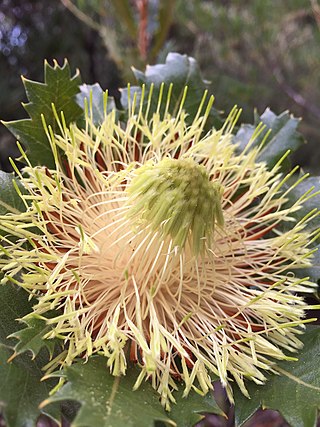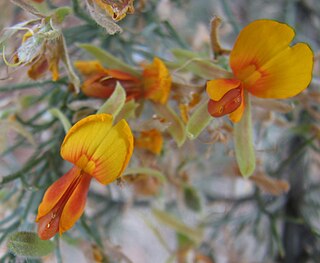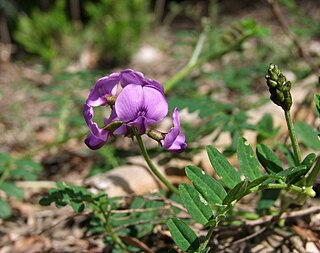
Banksia hewardiana is a species of openly branched shrub that is endemic to Western Australia. It has linear, serrated leaves with sharply pointed teeth, head of up to sixty lemon-yellow flowers and oblong follicles.

Banksia heliantha, commonly known as oak-leaved dryandra, is a species of shrub that is endemic to Western Australia. It has hairy stems, serrated, egg-shaped to wedge-shaped leaves, golden yellow flowers and partly woolly follicles.

Jacksonia furcellata, commonly known as grey stinkwood, is a species of flowering plant in the family Fabaceae and is endemic to the south-west of Western Australia. It is a prostrate to low-lying, or weeping erect shrub with greyish-green branches, sharply-pointed side branches, its leaves reduced to scales leaves, yellowish-orange flowers, and woody, hairy pods.

Xanthosia is a genus of flowering plants in the family Apiaceae and is endemic to Australia. It comprises 20 species of shrubs endemic to Australia. Plants in the genus Xanthosia are perennial herbs or small shrubs, the leaves divided, toothed or lobed,, the flowers white, pinkish or pale green and usually arranged in a compound umbel.

Eremophila brevifolia, also known as spotted eremophila, is a flowering plant in the figwort family, Scrophulariaceae and is endemic to the south-west of Western Australia. It is an erect, open, spindly shrub with sticky, short, serrated leaves and white to pink flowers and is only known from a few scattered populations.

Sambucus gaudichaudiana, commonly known as white elderberry, is a species of flowering plant in the family Adoxaceae and is endemic to eastern Australia. It is a perennial shrub but with stems that are produced annually with pinnate leaves that have three to eleven leaflets, small white flowers and small but edible fruit. It grows in cool forest and shady gorges.

Actinotus minor, commonly known as the lesser flannel flower, is species of flowering plant in the family Apiaceae and is endemic to New South Wales. It is a small, sprawling plant with grey-green leaves and white flowers.

Swainsona lessertiifolia, commonly known as coast swainson-pea, bog pea, Darling peapoison pea or poison vetch is an erect or ascending perennial herb in the pea family and is endemic to south-eastern Australia. It has 13 to 21 narrowly elliptic to elliptic leaflets, and racemes of mostly 12 to 25 usually purplish, rarely white flowers.
Teucrium sessiliflorum, commonly known as camel bush, is a species of flowering plant in the family Lamiaceae and is endemic to southern continental Australia. It is a tufted perennial herb with hairy, egg-shaped, lobed leaves and white or cream-coloured flowers.

Goodenia rotundifolia is a species of flowering plant in the family Goodeniaceae and is endemic to eastern Australia. It is a prostrate to erect perennial herb with more or less round, toothed leaves and racemes of yellow flowers.

Streptoglossa decurrens is a species of flowering plant in the family Asteraceae. It grows in Queensland, Western Australia and the Northern Territory. It is an upright, aromatic perennial herb or shrub with pink-purplish or reddish purple flowers.

Minuria leptophylla commonly known as minnie daisy, is a flowering plant in the family Asteraceae. It is a small perennial herb with white daisy-like flowers. It is endemic to Australia and grows in all mainland states.

Campanula petiolata is a flowering plant that is called western harebell when it is distinguished from Campanula rotundifolia or simply harebell when it is considered the same species. It is in the bellflower family (Campanulaceae). This herbaceous perennial is found in areas of western North America with continental climates. It produces violet-blue, bell-shaped flowers in late summer and autumn. It is closely related to Campanula rotundifolia and is considered either a subspecies or the same species by many botanists.

Dampiera adpressa commonly known as purple beauty-bush, is a flowering plant in the family Goodeniaceae. It is a small, understory shrub with purple flowers and grows in Queensland and New South Wales.

Xanthosia candida is a low-lying, perennial herb in the family Apiaceae and is endemic to the south-west of Western Australia. It has long, slender stems, irregularly toothed or lobed leaves and small white, green or creamy-yellow flowers.

Xanthosia huegelii is a weak, low-lying to erect or ascending perennial herb or subshrub in the family Apiaceae and is endemic to southern Australia. It usually has trifoliate leaves and hairy white flowers in umbels of 3 to 6.
Xanthosia peduncularis is a spreading perennial herb in the family Apiaceae and is endemic to the south of Western Australia. It has trifoliate leaves at the base of the plant and cream-coloured flowers in a compound umbel with 3 or 4 rays.

Styphelia serratifolia is a species of flowering plant in the heath family Ericaceae and is endemic to the south-west of Western Australia. It is an erect, bushy shrub, with broadly egg-shaped leaves with the narrower end towards the base, and red, tube-shaped flowers arranged singly in leaf axils.

Xanthosia singuliflora is a species of flowering plant the family Apiaceae and is endemic to the south-west of Western Australia. It is a tufted perennial herb with oblong to wedge-shaped leaves and sessile greenish-yellow flowers with 3 or 4 narrow bracts at the base.

Xanthosia tasmanica is a species of flowering plant in the family Apiaceae and is endemic to southern Australia. It is an erect or ascending perennial herb with trifoliate leaves with elliptic leaflets, and white flowers in a compound umbel with one flower per ray and sometimes another flower between the rays.


















